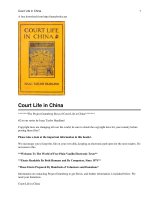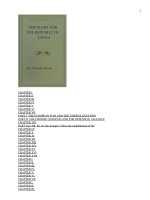slide corruption in china
Bạn đang xem bản rút gọn của tài liệu. Xem và tải ngay bản đầy đủ của tài liệu tại đây (158.38 KB, 13 trang )
Corruption in China
MARK 5940
Week 6 : Assessing Cultural/Corporate Environments
2
Group Members:
•
Irene Chan (2154259)
•
Yuli Yanti Tjia (3071213)
•
Joy Chu-Wui Teh (3047513)
•
Yu-ning Kuo (3048357)
•
Alisa Khosanunte (3081698)
•
Tzyy Jiann Soong (3038271)
3
Outline of Presentation
•
Introduction
•
Different types and classifications of bribes,
payments, or favors
•
Illegal bribes, payments, or favors under FCPA
•
Ethical response based on three ethical principles
•
China in the future
•
Alternatives to paying bribes in international
market
•
References
4
Definition
•
Bribery: voluntarily offered payment by someone seeking
unlawful advantage.
•
Extortion: payments which are extracted under duress by
someone in authority from a person seeking only what they
are lawfully entitled to.
•
Lubrication: a relatively small sum of cash, a gift, or a
service given to a low-ranking official in a country where
such offerings are not prohibited by law.
•
Subornation: large sums of money, frequently not properly
accounted for, designed to entice an official to commit an
illegal act on behalf of the one offering the bribe.
(Cateora and Graham, 2002)
5
Definition…cont’d
•
Foreign Corrupt Practices Act (FCPA): Act enacted
by Congress in 1977 and amended in 1988, which
forbids individuals as well as businesses and their
respective officers, directors, employees, or any
stockholders acting on their behalf, from paying money
or anything of value to a foreign official in order to
influence any act or decision of such official in violation
of his lawful duty.
( Klubes and Iraola, 1996)
6
Types & Classifications
Types
Bribery/
Extortion
Subornation/
Lubrication
1. Trips abroad B/E S/L
2. Sponsoring overseas
education
B/E S
3. Bribing officials to push
goods through customs/CIB
and other types of collusions
to beat the system
B/E S
7
Types & Classifications…cont’d
Types
Bribery/
Extortion
Subornation/
Lubrication
4. Direct requests for cash
payments
E S
5. Payments to customs officials
in a southern province to
reduce the dutiable value of
imports
B S
6. Engaging in black-market
trade of export-import licenses
B S
8
Foreign Corrupt Practices Act
(FCPA)
•
Illegal for companies to pay bribes to
officials, candidates or political parties
•
Penalties can arise
•
Issue of cultural acceptance
•
Country’s definition of term “illegal”
9
•
Utilitarian ethics
“Does the action optimize the common good or
benefits of all constituencies?”
•
Rights of the parties
“ Does the action respect the rights of the
individuals involved?”
•
Justice or fairness
“ Does the action respect the canons of justice or
fairness to all parties involved?”
(Cateora & Graham, 2002)
Ethical Response
10
China in the future: will bribery
become less prevalent in China?
No:
•
Developing country (NIC)
•
Standard of living
•
Collectivism – Guanxi
Yes:
•
Transformation from planned economy to market
economy
•
Pressure from other countries
11
Alternatives to Bribery
Company would
rely more on
government effort
Using government
lobbying and high-
level visits
Require an
investment of time
and energy
Problem
(especially bribery
related) would be
resolved quickly
Establishing a good
relationships with
the right people
ConsProsAlternatives
Promoting fair
trading
12
References
•
Cateora, P., Graham, J., International Marketing, 11
th
ed,
McGraw Hill, USA, 2002.
•
Cheng, Allen T., Chung, Yulanda, China: Power Corrupt,
Asiaweek, Hongkong, 2001.
•
Deresky, H., International Management, Manging across
borders and cultures, 4
th
ed, Pearson Education, Inc., New
Jersey, 2002.
•
Klubes, B., Iraola, R., Complying with the FCPA in an era of
globalized trade: A primer for U.S. businesses - Part I:
Provisions, exceptions, enforcement, East Asian Executive
Reports, Washington, 1996, Vol. 18, Iss. 2; pg. 9-12.
13
References…cont’d
•
Lane, Henry W., Simpson, Donald G., Bribery in International
Business: Whose Problem Is It, Journal of Business Ethics,
1984, vol. 3, pg. 35 – 42.









